Speech by the Governor
Zhejiang Province is situated along the shore of the East Sea of China, neighboring Shanghai on the north. Zhejiang is an important cradle of Chinese ancient civilization and is known as “land of fish and rice, home to silk and tea, a place of rich cultural heritage and a paradise for tourists”. Since the reform and opening up, Zhejiang has become one of the provinces with most prosperous economic development and high-level living standards, owing to its favorable location, profound cultural inertia, excellent human resources and taking the lead in advancing systematic innovation.
From the present time to a period to come, Zhejiang is in a new historical juncture when the province is focusing on building a moderately prosperous society and accelerating the pace of modernization. Zhejiang, with its increasingly opening up pace, vigorous development and predominant environment, is providing great opportunities for domestic and international commerce cooperation and friendly exchanges. Welcome to Zhejiang for investment, cultural exchanges and tourism.
I . Survey
(i)Geographic Location
Zhejiang is located in the southern part of the Yangtze River Delta on the southeast coast of China. It lies in between north latitude 27 º 01’ and 31 º 10’, east longitude 118 º 01’ and 123 º 08’, with a total area of 101.8 thousand km2. It faces the East China Sea on the east and Fujian on the south. With an extensive hinterland in the rear, it borders Jiangxi and Anhui on the west and Shanghai, and Jiangsu on the north.
Zhejiang province features complex landforms, with 70.4% of mountainious regions and hills; 23.2% of plain and basins; 6.4% of rivers and lakes and only 2.0817 million ha. of farmland.
Zhejiang is renowned for its picturesque landscapes. It boasts famous lakes such as the West Lake in Hangzhou, the East Lake in Shaoxing, the South Lake in Jiaxing and the Dongqian Lake in Ningbo. The Thousand-Islet Lake in Chun’an County of Hangzhou is the largest man-made lake in the country. Major rivers in the province include the Qiantang River, the Oujiang River, and the Nanxi River. The Beijing-Hangzhou Grand Canal runs through the northern part of the province, and merges into the Qiantang River in Hangzhou.
Zhejiang has two sub-provincial cities, namely Hangzhou and Ningbo(Ningbo is a citiy with separate planning status). Wenzhou, Huzhou, Jiaxing, Shaoxing, Jinhua, Quzhou, Zhoushan, Taizhou and Lishui are the 9 prefecture-level cities, and there are 36 counties, 22 county-level cities, 32 sub-city districts and 837 towns in Hangzhou province.
(ii)Climate
Zhejiang is located between Eurasian Continent and Northwest Pacific Ocean on the east coast of China. Under the typical subtropical monsoon conditions, the climate of Zhejiang is characterized by four distinctive seasons, abundant sunshine and rainfall, moist air and diverse climate characteristics. It has an annual average temperature of 15-18 ºC with the extremely maximum temperature of 33-43 ºC and minimum temperature of -2.2-17.4. It has an annual average rainfall of 980-2,000mm with the climax of 2,200mm as well as an annual sunshine hour of 1,710-2,100.
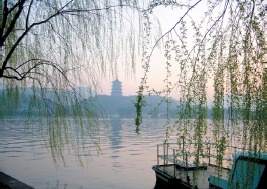
(iii)Population and Ethnic Groups
The permanent population of Zhejiang reached 48.98 million in 2005, among which the non-agricultural population amounted to 27.42 million and the agricultural population totaled 21.52 million. The population of Han nationality came to 48.42million, accounting for 98.93% of the whole population. There are 53 ethnic minorities in Zhejiang, including mainly She, Tujia, Miao, Buyi, Hui, Zhuang, Dong nationalities.
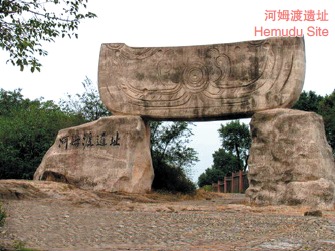
(iv)Infrastrure and Transportation
Railways
A railway transportation network, with the capital city Hangzhou as its center, has been formed in Zhejiang by intensive railway lines including 3 double–track railway lines ,namely Shanghai-Hangzhou, Zhejiang-Jiangxi, Hangzhou-Ningbo,and 4 trunk lines, that is, Hangzhou-Xuancheng (Anhui), Jinhua-Wenzhou, Xinyi-Changxing and Jinhua-Qiandaohu (Chun’an). The length of railways in operation in Zhejiang is 1,212km with the passager-carrying capacity of 51.17million and cargo-carrying capacity of 28.06 million tons for a full year.Zhejiang has the direct access to all major cities in China.
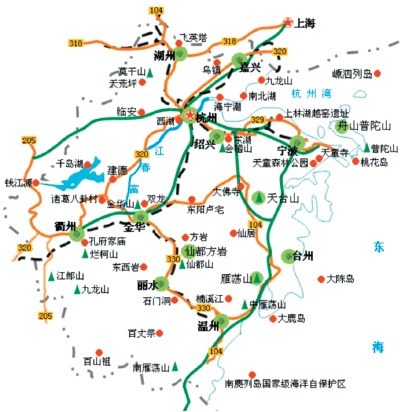
Highway
The total length of highways in Zhejiang is 46,935 km, among which 1,475 km are expressways and 2,487 km are Class I roads. A highway network has been basically established, connecting the capital city Hangzhou with all the other counties and cities of Zhejiang and other neighbouring provinces.
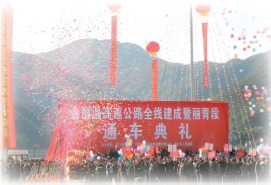
Airports
There are 7 civil airports in Hangzhou, Ningbo, Wenzhou, Zhoushan, Yiwu, Taizhou and Quzhou, with an annual takeoff of 129,000 sorties, passager handling capacity of 11.41million and goods post handling capacity of 242,000 tons. These airports have direct links with over 30 large-and-middle sized cities such as Beijing, Shanghai, Guangzhou, Shenzhen, Hongkong, etc as well as direct flights to many foreign cities such as Seoul, Bangkok, Tokyo, Osaka, Singapore and Busan.
Ports
With 9,893 km inland waterways, Zhejiang has 5,495 inland harbor berths and 958 seaport berths, among which 71 can berth 10 thousand tons and above. There are five major ports, namely Ningbo, Zhoushan, Wenzhou, Taizhou and Jiaxing. The total handling capacity of seaports reaches 310 million tons. Beilun habour in Ningbo, which can berth freighters of over 300,000 tons, is one of four international entrepots in China. Aoshan port in Zhoushan, being able to berth the super tankers of 250,000 tons, is the largest petroleum transfer port in China.
Finance and Insurance
In 2005,the total deposit balance in RMB and foreign currency of the financial institutions reached 1,541.6 billion yuan, the total loan balance in RMB and foreign currency of them amounted to 1,241.9 billion yuan and balance of saving deposits of rural and urban residents of this year came to 688.9 billion yuan.
Main Financial Institutions in Zhejiang Province

In 2005, a full year’s premiunm totaled 26.03 billion yuan, among which the property insurance premiun added up to 7.18 billion yuan, life insurance premiun reached 18.85 billion yuan and the total indemnity expenditure and payment arrived at 6 billion yuan.
Post and Telecommunications
The urban and rural fixed telephone switching system has a total capacity of 26.23 million sets. The urban and rural fixed telephone subscribers reached 19.75 million, with the popularity of 59.8 sets per hundred capita. The urban and rural mobile telephone subscribers reached 23.23 million, with the popularity of 49.2 sets per hundred capita. The registered Internet users, including Broad Band Users, reached 5.06 million. 37,882 administrative villages have access to fixed telephones, accounting for 99% of the total. The mobile telephones reach all parts of Zhejiang Province. The postal express mail network integrates a variety of comprehensive transportation means such as airways, railways, highways, etc. The international mail exchange offices have been set up in Hangzhou, Ningbo and Wenzhou. The automation level of the newly-built Hangzhou Center for Handling Mails ranks top in China.
(v) Foreign Exchange
Since the start of the reform and opening to the outside world, Zhejiang province has established friendly relations with 72 cities including New Jersey, Shizuokaken, Schleswig-Holstein, Parana, etc. Many cities such as Hongzhou and Ningbo have also established friendly relationships with foreign cities.
Table of Friendship States/Provinces and Cities of Zhejiang Province
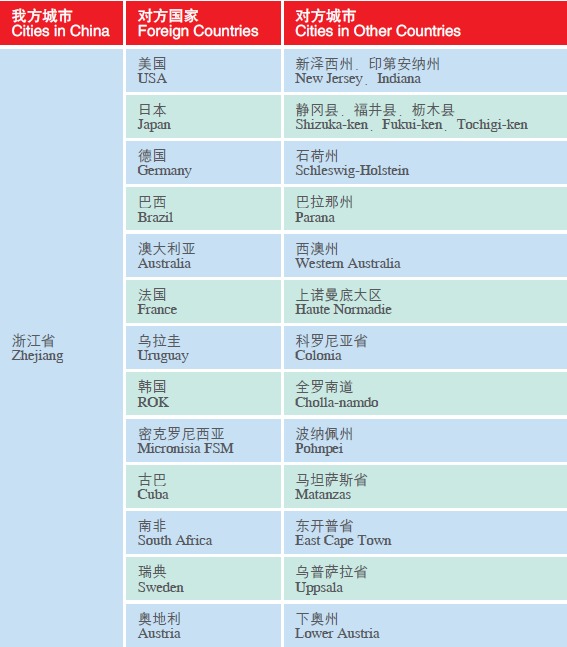
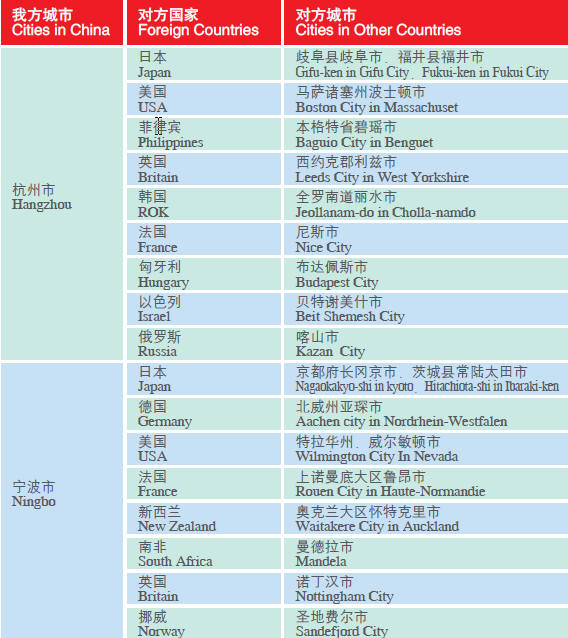
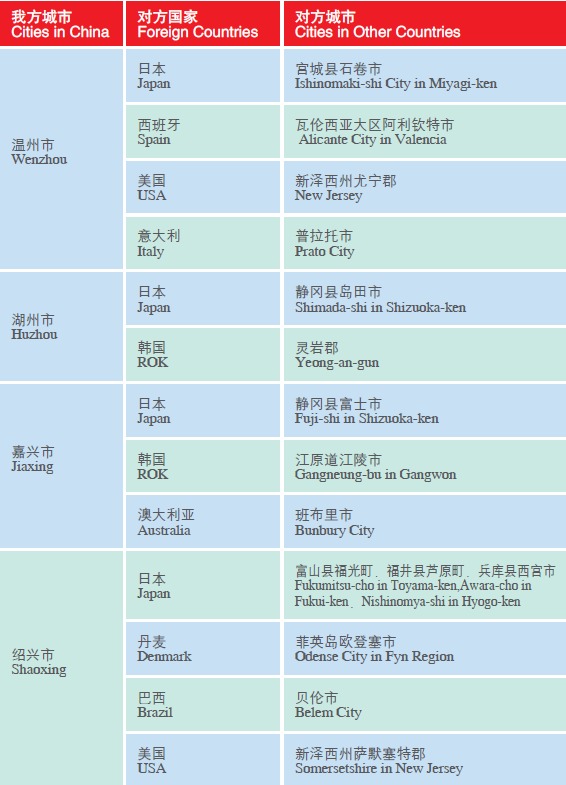
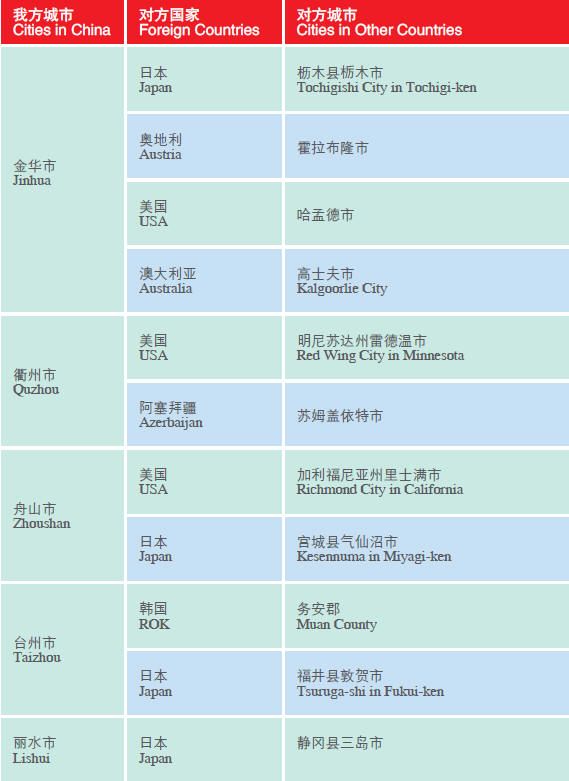
Foreign Exhibitions in Zhejiang Province
China Yiwu International Commodities Fair (Yiwu Fair for short), whose predecessor is China Yiwu Small Commodities Fair first held in 1995, is the only international daily consumer goods fair approved by the State Council . Since 2002,the fair has been promoted to an international fair sponsored by Ministry of Commerce. So far, it has been held for 11 successive years. The fair plays an important role in enlarging the export of commodities, promoting the small commodity manufacturing industry and boosting the development of the regional economy with the purpose of facing the world and serving the country .Meanwhile, it has become the largest, most influential and productive commodity fair, which is on the top of exhibitions in China. Zhejiang Investment & Trade Symposium (ZJITS) is sponsored by Zhejiang Provincial People’s Government, and China International Consumer Goods Fair (CICGF) is sponsored by China National Ministry of Commerce and Zhejiang Provincial People’s Government. ZJITS and CICGS, being held in Ningbo from June 8th to 12th every year, is a carrier for Zhejiang to introduce capital, technology, talented personnel and managerial expertise and also a platform to promote the further opening-up of Zhejiang Province. Since 1999, seven symposiums have been held successively. The province has received a total of 50,000 overseas guests from 109 countries and regions, with more than 2,395 foreign funded projects and contractual foreign investment of over 18.3 billion US dollars. Meanwhile, the accumulative volume of business for foreign trade had hit 2.473 billion US dollars since CICGF was held during the same period as ZJITS in 2002.
2006 Hangzhou World Leisure Exposition is a theme exposition first jointly sponsored by All-China Federation of Industry and Commerce, Zhejiang Provincial and Hangzhou Municipal People’s Government and the relevant ministries and commissions directly under World Leisure Organization, China National Tourism Administration. Taking “Leisure-Changes Peoples’ Lives” as its theme, the exposition integrates leisure, tourism, recreation, conferences, exhibitions and grand events as a whole, interacts with the 8th West Lake Exposition ,popularizes the advanced leisure notion, advocates the healthy leisure style and enables people to enjoy the high-quality leisure services and promotes the brand of “Oriental Leisure City”.
Table of Foreign Exhibitions in Zhejiang Province
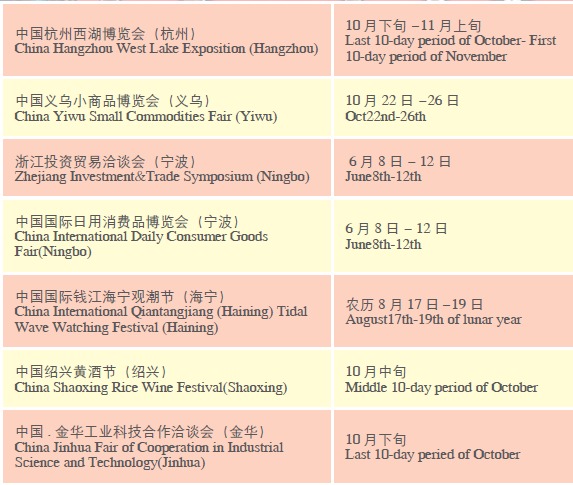
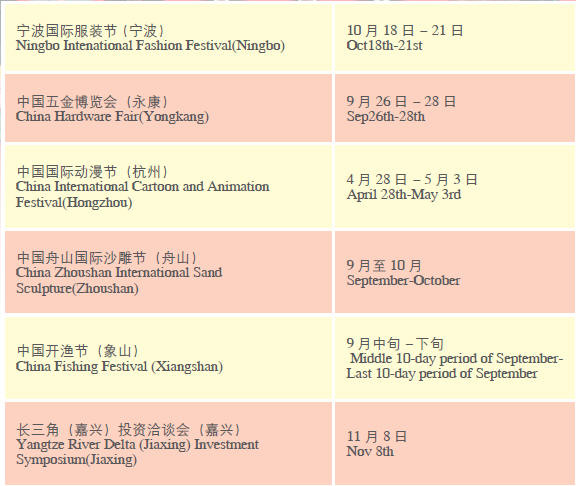
(vi) Higher Education and Scientific Research
There are 73 regular full-time institutions of higher education in Zhejiang province. The total number of students on campus reaches 572,800 including 16,254 postgraduates for master’s degrees and 5,808 Ph.D. candidates. There are 395 fulltime vocational schools, among which there are 128,100 secondary vocational school students, 547,300 on-campuses vocational high school students, 53,200 adult secondary vocational school students and 177,800 adult college students. The institutions of higher education, entitled to confer master’s degrees in 481 programs and doctoral degrees in 193 programs, have altogether 22 academicians from Chinese Academy of Sciences and Chinese Academy of Engineering. There are more than 10 key universities such as Zhejiang University, Zhejiang University of Technology, Zhejiang Normal University. Among which Zhejiang university, as one of the best universities in China, is well-known both at home and abroad, and is praised by Dr. Jeseph Needham as “Oriental Cambridge”.
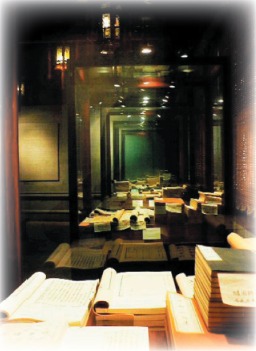
In 2005, there was RMB 30 billion spent on the scientific and technical activities, occupying 2.25 per cent of the provincial GDP. Zhejiang has over 200 independent R&D institutions of county level and above, among which there are 105 National and Provincial Key Laboratories, and 21 State Engineering Technology Centers.
(vii)Tourism
Zhejiang boasts a beautiful landscape and a galaxy of talents. The mountains stretch one after another, the plains crisscross with each other, the rivers flow continuously and the islets spread all over. The picturesque scenery is formed by the mountains, rivers, lakes, beaches, forests, caves and springs, revealing varied landscapes. The marvelous spectacle fosters numerous celebrities, attracted enormous outstanding figures and reserve a large number of places of cultural heritages. There are over 800 important geomorphological sights, more than 200 watery sights and over 100 biological sights and 100-odd places of cultural interest. It has 14 scenic areas of national level, namely, the West Lake, Fuchun-Xin'an Rivers, Yandang Mountain, Putuo Mountain, Nanxijiang River, Tiantai Mountain, the Shengsi Islands, Xuedou Mountain, Mogan Mountain, Double Dragon Cave, Xiandu, Xuedou Mountain, Five Waterfalls (Wuxie), Jianglang Mountain, Xianju and 42 of provincial level including Dongqian Lake, the Big Buddha Temple, lanke Mountain etc. Zhejiang also has 5 famous historical and cultural cities at national level, that is, Hangzhou, Ningbo, Shaoxing, Quzhou and Linhai and 12 at provincial level. There are 279 historical and cultural sites under provincial protection, 7 nature reserves at national level, 20 forest parks at national level.
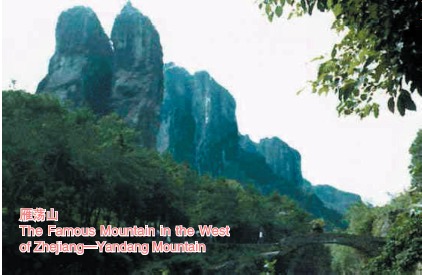
West Lake occupies an area of 6.03 square km. The west Lake is divided by Su Causeway and Bai Causeway into five parts including Outer Lake, North Inner Lake, Yue Lake, West Inner Lake and Small South Lake. Three islets of the Outer Lake including Lesser Yingzhou, Mid-Lake pavillion and Ruangong Isle mount the lake and show the graceful bearings, displaying a scene just like Penglai wonderland in the fairy tales. When Su Dongpo, a celebrated poet of the Song dynasty, was the prefecture chief of Hangzhou, he wrotes a poem in praise of the West Lake,
“The West lake, like Xizi, the classic beauty, who is invariably enchanting in either light or heavy makeup.”
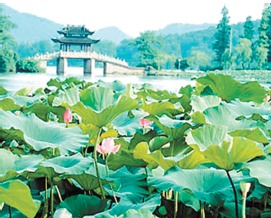
Tiantai Mountain boasts an enchanting scenery with a lot of places of historical interest. In accordance with its geographic location and characteristics, it falls into 13 scenic spots, among which 8 sights such as Shiliang Waterfall, Sunset Clouds on the Huading peak, etc are the most famous. With stones whose colour is just like fire, the castlestyled Chicheng Hill is the birthplace for both Buddhism and Taoistm. Tiantai Mountain is a place for men of talents. As early as the period from Han to Jin dynasty, Gexuan, Gehong and Tao Hongjing came here to cultivate themselves according to religious dictrines and make pills of immortality. Afterwards, those famous monks and Taoist priests also came to the mountain to found new religious schools or live in seclusion to write books. Therefore, Tiantai Mountain becomes a celebrated tourist attraction with the fame of “Holy Mountain of Buddhism.”
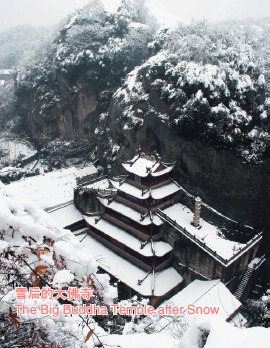
Putuo Mountain, situated in the central Putuo District in Zhoushan , is among the first scenic spots at national level announced by the State Council. Being one of the four Famous Buddhist Mountains in China with Wutai Mountain, Emei Mountain and Jiuhua Mountaini, it enjoys the reputation of “Buddhist Fairyland on the Sea” throughout the country and beyond for its long history of buddist culture and unique sceneries of mountains and sea. The Putuo Mountain derives its name from Sanskrit and it was called “Meiling Mountain” before the Tang and song Dynasty. During the late Tang Dynasty, there appeared some Buddhism events. At present, there exist 3 big Buddhist temples, namely, Puji Temple, Fayu temple and Huiji Temple,and over 30 monastaries including Dasheng, Fumei, Yangzhi, etc.

(viii)Local Products and Food
Local Products
Zhejiang Silk: Zhejiang Silk is classified into 14 kinds including silk fabric, satin, brocade, suiting silk, leon, etc with the magnificent patterns, over 200 varieties and more than 2,000 designs. Winning the Award for High Quality at Provincial and National level for many times ,it has been sold to faraway markets in 100-odd countries and regions throughout the world and praised as “Flower of Oriental Art” by international friends.
Wangxingji Fan: Wanxingji Fan has a wide range of fans such as black paper fan, sandalwood fan, silk fan, white paper fan, feather fan, round silk fan etc.
Zhang Xiaoquan: Zhang xiaoquan Scissors enjoys high fame both at home and abroad for its choice materials, even ringed -steel, fine grinding work, extreme sharpness, exquisite styles and strong durability.
Local Food
Longjing Tea: The mountains surrounding the West Lake are the home of Longjing Tea. Longjing Tea is constantly commended because of jade colour, rich fragrance, mellow taste and beautiful features. It also contains rich chemical elements such as amino acid, chlorophyll, vitamin C, etc. Jinhua Ham: Coming into being from Southern Song Dynasty, Jinhua Ham has a long history of over 800 years.
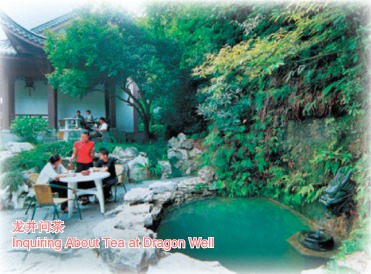
West Lake Lotus Root Starch: The lotus root starch is the famous brand of the same kind. It is the nourishment most suitable for babies, the old and patients for many uses including promoting salivation, reducing fever, moistening the lung, replenishing vital essence, etc.

Zhejiang Province has other local food which are renowned both at home and abroad such as “Wufangzhai” Zongzi (pyramid shaped dumplings made of glutinous rice wrapped in bamboo or reed leaves), Haining Leather, Wuzhen Sisters-in-law Cake, Fengqiao Torreya, Shaoxing Wine, Shaoxing Preserved Beancurd, Shaoxing Moulded dried vegetable, Shaoxing Wuzhan Hats, Shengzhou Bamboo Knitting, Ling lake Fishing, Huzhou Writing Brush, Silver Fish, Taihu lake Crabs, Xiaoshan Dried Tunip, Jinhua Crisp Cake, Tongyang Wood Carving , Shousheng Rice Wine, Kuding Tea, Huangyan Orange, Yuhuan Orange, Qingtian Stone Carving, Qingyuan Mushroom, Taro, Yuyao Preserved Vegetable, Large Yellow Croaker, Common Eel, Saltedcrab, Salted Crab Paste, Dongsha Smoked Beancued, etc.
Related Articles:
Doing Business in Zhejiang Province of China: Economy
Doing Business in Zhejiang Province of China: Investment
Doing Business in Zhejiang Province of China: Development Zones





